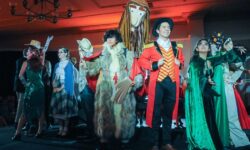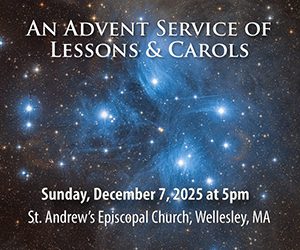[ccfic caption-text format="plaintext"]
By James Kinneen
Hometown Weekly Reporter
On Friday afternoon in the Sherborn Community Center, Jack Craig presented the first part of his “story, accompanied by music, wrapped in a production” titled “American Musical Theatre: The Early Beginnings.” Throughout the day, Craig would first explain the history that led up to the creation of the showtune, then play it on the piano and encourage the crowd to sing along.
Craig explained that “in the early days of American history, we were a little too busy with other things, like how to grow corn and fight the American Revolution,” so the creations of things like theatre spaces exclusively built for shows would take years to come to fruition. Instead, the first shows were performed in all sorts of places, with Craig pointing out that “Flora” was performed in a courtroom in the off hours when court wasn’t taking place.
While Craig acknowledged minstrelsy’s checkered past, he argued that it was impossible teach American musical theatre without acknowledging it. Craig talked about the traditional structure of the shows, noting that “burlesque was last because they needed to make sure the guys would stick around,” while John Gay’s “Beggar’s Opera” consisted of 69 songs in three acts because “there was no TV or radio to keep you entertained, so you didn’t mind spending a lot of time there.”
While we view these shows as puritanical by today’s standards, Craig was quick to point out that “The Black Crook” featured what was essentially nudity almost 100 years before “Hair.”
When it came time to sing, Craig chose “Toyland” for the first song because “everyone learned it in grade school, and if you didn’t, shame on your teachers!” While most everyone was familiar with the chorus, Craig made sure that the verse was sung, as well, because “we shouldn’t ignore MacDonagh’s words and Herbert’s music.”
Before he performed “School Days” and “Give My Regards to Broadway,” Craig explained that Gus Edwards began as a child stooge and was discovered by George Cohan. “Child stooges were little kids that were planted in the audience that knew the words, so they would get pulled up onstage to wow the audience,” he explained. “I should have done that with one of you, even though none of you are children,” he jokingly added.
While Cohan discovered Edwards, Edwards was the real “star-maker,” having discovered people like Groucho Marx, Eddie Cantor and The Duncan Sisters.
Craig would go on to perform “Ma, He’s Making Eyes at Me,” stopping briefly to point out how dated the lyrics had become. “I taught high school for years,” he said. “You try telling kids that ‘leaning on my shoulder’ means ‘he’s getting bolder.’”
Craig’s last song of the day was “Can’t Help Lovin’ Dat Man” from Oscar Hammerstein II and Jerome Kern. The song was composed in 1927, which is the last year that Craig’s first lesson would encompass.
Jack Craig’s next lesson will cover the music of the Depression, from 1927 to around the mid-1930s. If you go, you will undoubtedly be both informed and entertained as you learn and sing along to the biggest hits of early American musical theatre.

























